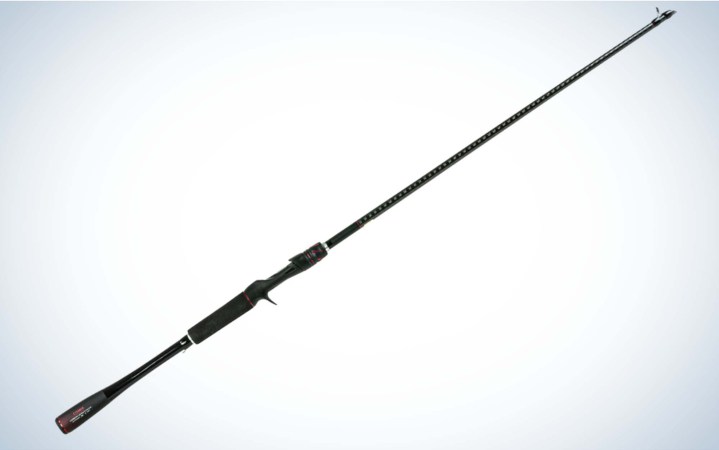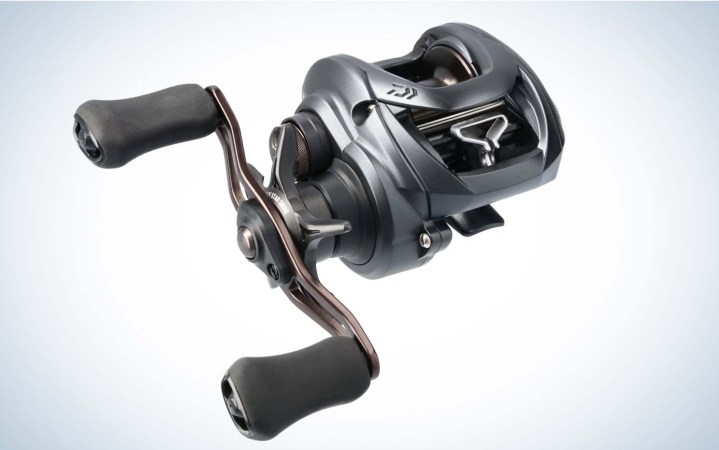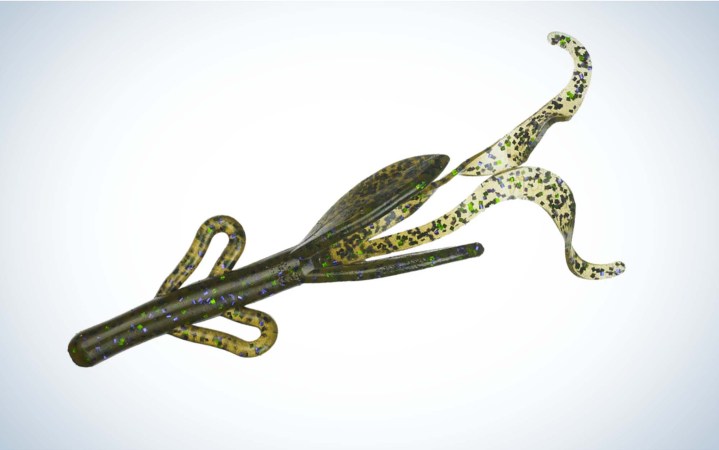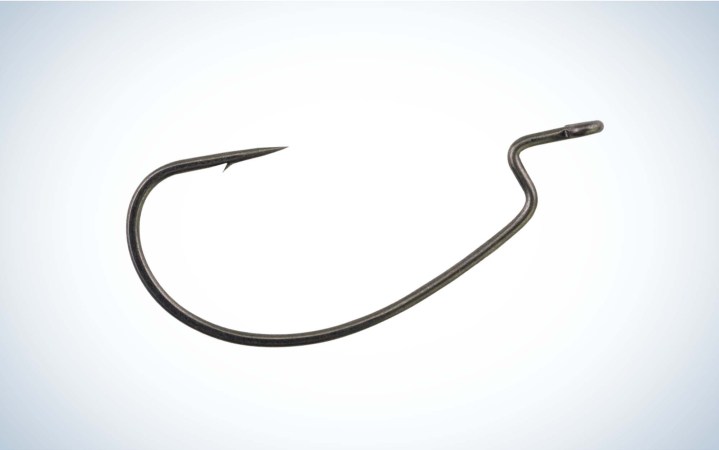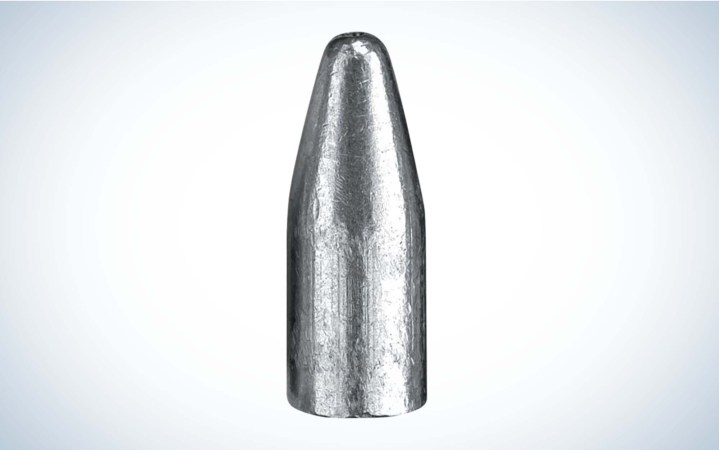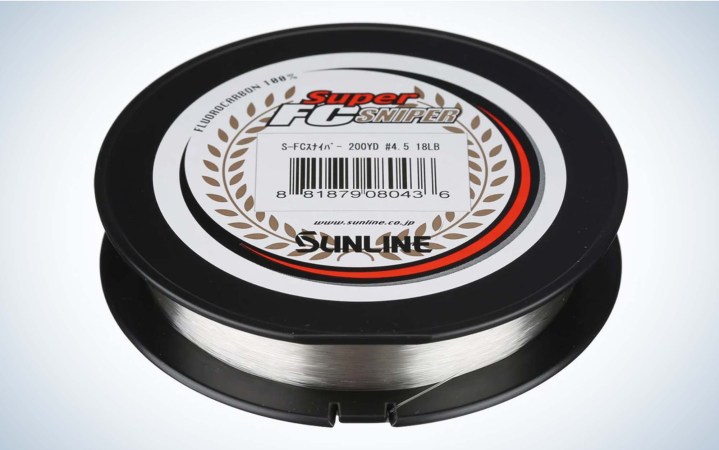The Texas rig just might be a bass angler’s best option for early summer action. There are limitless options of bait styles you can put on your hook, and depending on the size of your bullet weight, there are endless ways to fish it.
Most bass anglers learn the Texas rig as one of their first bass-specific techniques, and for a good reason. It is an incredibly versatile rig that tricks both aggressive and lethargic bass. It’s also straightforward to rig up, making it a go-to for beginner anglers.
You can fish a Texas rig anywhere, but it truly shines in and around underwater vegetation or in laydowns along the bank. In any case, if you’re headed out for a day of early summer bass fishing, don’t sleep on the Texas rig. Here’s everything you need to know to catch bass on this technique.
Topics Covered
The Texas Rig
Photo by Derek Horner
The standard Texas rig consists of a bullet weight and an EWG hook with a soft plastic rigged onto the hook to make it weedless. If you’re fishing in thicker grass, sometimes it can help to add a small rubber peg, also known as a bobber stopper, on the line above the bullet weight to keep the weight and bait in contact to reduce the amount of weeds that could get stuck on your line. In most scenarios, however, I prefer to go with an unpegged Texas rig to maximize the action of my soft plastic.
As for the soft plastic you choose, your options really are endless. To make your life a bit easier, I recommend using a stick bait, a ribbontail worm, a creature bait, or a crawfish imitator. Those four soft plastics are my go-to options when I’m rigging up for some early summer post-spawn action.
How to Rig a Texas Rig

Photo by Derek Horner
A Texas rig should take no more than a minute to be ready to fish. The hardest part will be rigging your soft plastic straight and weedless on the hook. Below is a step-by-step guide.
Step 1: Select your Texas rig hook. Typically, an 2/0 or 30/0 EWG hook.
Step 2: Select your bullet weight. Typically a lead or tungsten bullet weight from ⅛-ounce to ½-ounce.
Step 3: Thread your bullet weight onto your line. Then, using a Palomar knot, tie your line to the Texas rig hook. (If you’re using a bobber stopper, thread that onto your line prior to adding the bullet weight.)
Step 4: Select your soft plastic and rig it onto the hook weedless. For further explanation, here’s a quick tutorial.
What Makes the Texas Rig so Effective?
The Texas rig has caught bass in every state where bass exist. It’s not just a beginner’s technique, many professional anglers rely on the Texas rig to produce bites when it matters most. But why?
The versatility of a Texas rig is what makes it so effective. Having the ability to put practically any soft plastic bait on your hook and fish it effectively can’t be understated. Most other techniques won’t be very effective if you’re not using the right type of soft plastic. But the Texas rig seems to shine no matter what you want to throw. Swimbaits, stick baits, creature baits, crawfish imitators, and big ribbontail worms will all catch fish on a Texas rig. Having a banner day simply requires figuring out where and how you’re going to fish this weedless rig.
Furthering a Texas rig’s versatility is controlling your bait’s fall rate. Fall rate may be a bit more of an advanced term, but it’s pretty self explanatory. With the ability to select any size bullet weight, you have all of the power to have your soft plastic slowly sink through the water column, or have it rocket to the bottom. Depending on the mood of the bass and the weather conditions, those options could make all of the difference in getting a bite or getting skunked.

Photo by Derek Horner
The fall rate can also be affected by the use of a bobber stopper. Putting a bobber stopper above your bullet weight can keep the entire rig together, allowing it to slip in and out of holes in the grass more easily. The downside is that you don’t get nearly as much action from your soft plastic. Without a bobber stopper, on a slack line, your bullet weight will sink to the bottom, but your soft plastic will slowly glide towards the bottom while enticing hungry bass into biting. As you hop the weight along, the soft plastic will dance behind it, leaving space between the weight and the bait, causing action in the soft plastic that’s hard to replicate using any other technique.
However, my favorite part of this technique is that it catches both largemouth and smallmouth the same. In the early summer, both bass species congregate in and around grass lines to feed. As ambush predators, the aquatic vegetation provides the perfect spot to sit and wait for an unsuspecting baitfish or crawfish to meander by. When that baitfish or crawfish is your Texas rig, they won’t know the difference.
In my opinion, when it comes to fishing for springtime or early summertime bass, there’s no better technique than a Texas rig.
For a deep dive video on the Texas rig, check out this great video from my friend TylersReelFishing.

When to Throw a Texas Rig
Typically, fishing a Texas rig around aquatic vegetation in the early summer is a surefire way to get a few bites. By the early summer, most of the bass have finished spawning in the shallows and have now pushed back to deeper water to find their summer haunts. Grass lines in 8 to 15 feet of water make a perfect location for ambushing their prey and hiding from other predatory fish like muskies.
I’ve found over the years that the best grass line or weed bed consists of two types of grass converging together. Whether that’s milfoil and hydrilla, eelgrass and waterweed, or any other combination you can dream up, finding those areas can lead to some of the best days you’ll have fishing a Texas rig.

Photo by Derek Horner
I wouldn’t recommend using a bobber stopper when you’re fishing younger, emergent grasses. You’ll see much more benefit having the increased action in your bait and you shouldn’t reel back too many weeds. But as the summer wanes on and the grass gets thicker, a bobber stopper might be necessary to get your bait through the holes in the grass and to the bottom where the bass lie in wait.
As you fish in and around grass, you’ll learn that losing fish in the grass is just a part of the game. Not every hooked fish will end up in your hands, they’re pretty good at digging into the thickest weed patch they can find to avoid capture. The Texas rig, however, seems to be a technique that leads to fewer lost fish than other popular grass fishing options.
The reason why boils down to how the fish are typically hooked on a Texas rig. It seems like nine out of ten times, when you set the hook with a Texas rig, the hook is buried right where you want it, in the roof of their mouth. This location allows you the most control over the bass during the fight, and once the hook is in there, it’s not easy for the bass to shake it. Having the right rod, reel, and line setup will only improve your likelihood of success and reduce the amount of fish you lose to the grass. Here’s the gear you need.
Texas Rig Setups, Baits, Hooks, and Weights
Picking the Right Texas Rig Rod
Due to the versatility of the Texas rig, picking the right rod truly comes down to personal preference and knowing where you’ll be fishing a Texas rig most of the time. For me, that’s in emergent or medium-density grass lines, so my rod of choice will reflect that. But, if you plan to fish in heavier grass, a heavier action rod will always be a safer bet.
You can fish a Texas rig on a spinning rod, but I almost always reach for a baitcasting rod as it gives me more control when casting and fighting the bass back to the boat. Typically, I’ll pick up a 7 foot, medium action with a moderate tip. My favorite rod for this is the Shimano Zodias. The versatility of this rod choice matches the versatility of the Texas rig beautifully.
Picking the Right Texas Rig Reel
Since I’ve recommended fishing your Texas rig on a baitcasting reel, we’ll stick in that vein, but if you want to fish it on a spinning rod, check out the best spinning reels to use with it. As for the baitcasting reel, I prefer a low-profile reel with a solid drag. The low-profile reel gives me even more control when I’m casting or pitching the Texas rig in and around the grass. My favorite reel for these Texas rig scenarios is the Daiwa Tatula Elite 100HSL. It offers an incredibly smooth casting experience, and the draw works flawlessly, even when the bass digs into thick grass, which requires some patience and pulling to get them out.
The Best Texas Rig Baits
As I’ve mentioned before, you can fish practically any soft plastic on a Texas rig. But, for the sake of brevity, I’m going to list out three of my favorites.
When fishing around laydowns in the early summer, I often find myself reaching for some type of creature bait like a Zoom Baby Brush Hog. The Baby Brush Hog offers just enough action to entice bass holding tight to the tree limbs into biting.
When fishing in younger, emergent grasses, I tend to rig up a 7-inch Berkley PowerBait Power Worm. The action in the tail is unbeatable, and when I put on a smaller bullet weight, this worm dances through the water column just above the grass and drives bass nuts.
If I find myself fishing a Texas rig in thicker grasses like milfoil or hydrilla, I like to go with a beaver style creature bait. My favorite is the Reaction Innovations Sweet Beaver. This streamlined bait paired with a bobber stopper and heavier bullet weight allows the Texas rig to slip through thicker grass and find its way to the bottom where hungry bass are waiting to ambush.
The Best Texas Rig Hooks
When deciding on which hook to throw on your Texas rig, don’t stress over it too much. As long as your hook is sharp and isn’t going to break on you, any EWG hook will do. My choice is almost always a 3/0 Berkley Fusion19 Superline EWG Hook. These hooks are sharp and have never let me down.
Bullet Weights for Texas Rigs
The bullet weight you choose for your Texas rig is one of the most important pieces of the puzzle. Picking the right weight for each situation is paramount. Lucky for you, bullet weights are offered in nearly any size you can imagine. Typically, I stay within ⅛-ounce to ½-ounce for my bullet weights.
As for the material the weights are made of, you have options there too. For the average angler, lead weights should be just fine, but if you’re looking to up your Texas rig to the next level, a tungsten bullet weight will offer you more sensitivity and feedback as you work your bait along the bottom. Below are my favorite options for lead and tungsten bullet weights.
Line for Texas Rigs
When it comes time to spool up your Texas rigging baitcasting reel, look no further than 12-pound Sunline Super FC Sniper Fluorocarbon Line. The fluorocarbon line will be the best option for your Texas rig as the line is slow sinking in and of itself, helping the action of your bait as it falls through the water column.
Final Thoughts and Tips on How to Fish a Texas Rig
As you can see, there are a million and one ways to rig up a Texas rig. From weight selection to deciding the right soft plastic, rigging a Texas rig can be daunting if you let it. Instead, I’d recommend picking a 1/4-ounce weight and your favorite soft plastic bait and heading to the water. More than likely, you’ll get a few bites before the day is over and your confidence will skyrocket.
From there, experiment with different baits and weight combinations. Each weight and bait combination will have a different fall rate and action. Figuring out a few favorites will help you narrow down the gear you really need for your next fishing trip.

